Best studio desks 2025: budget-spanning options for organising your recording studio space
Streamline your production setup and bring order to your creative space with one of the best desks for music production
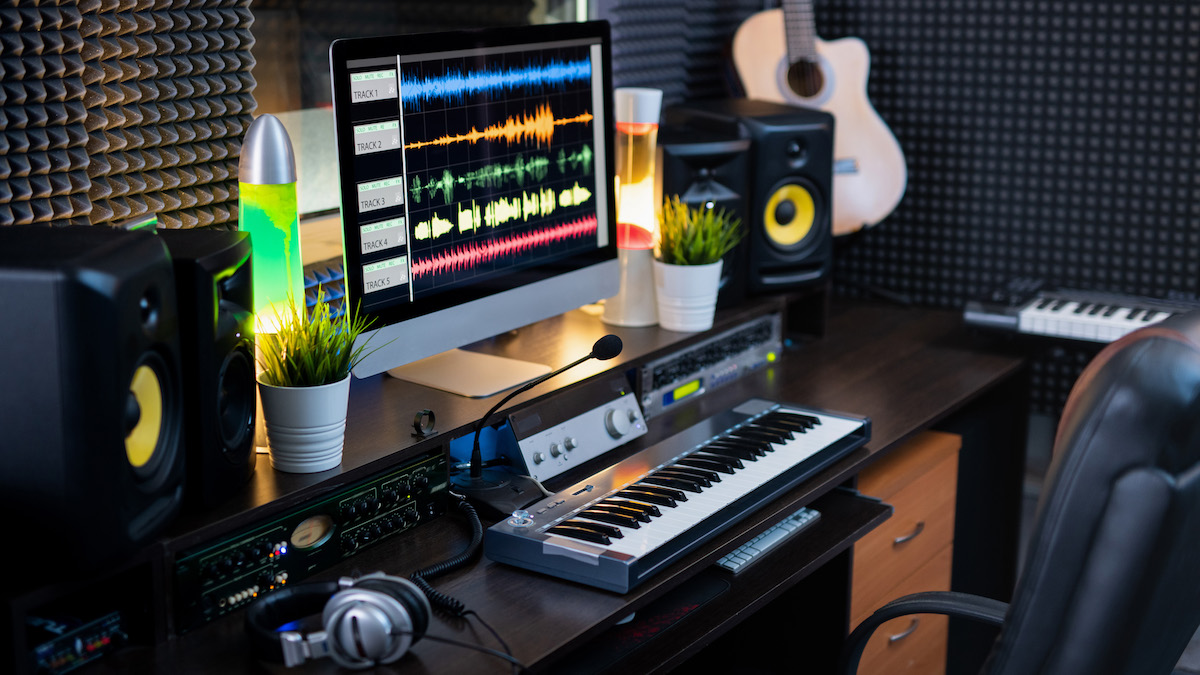
If you want to start taking your music-making a little more seriously, getting one of the best studio desks installed in your creative space is a surefire way to supercharge your workflow. Whether you're recording full bands, composing for film, or just creating music entirely in the box, we've picked out a selection of desks that will suit any music creator's needs.
As well as looking cool, a desk for music production allows you to optimize your listening position with monitor stands, integrate a MIDI controller with a keyboard shelf, and integrate analogue outboard gear with dedicated rack space. Upgrading your desk can have a transformative effect on your workflow, allowing you to organize your gear efficiently, maintain a consistent listening position, and speed up your workflow by getting your most used tools within easy reach.
When selecting a desk for a home recording studio, your main limitation is likely to be the size of the space. You want the desk to sit in the ideal spot in your room, so we've included dimensions for all of our picks to help you make a decision. We've also put the desks in this guide head-to-head in our specs comparison section, and we've got loads of useful information in our how to choose and FAQ sections.
Product guide
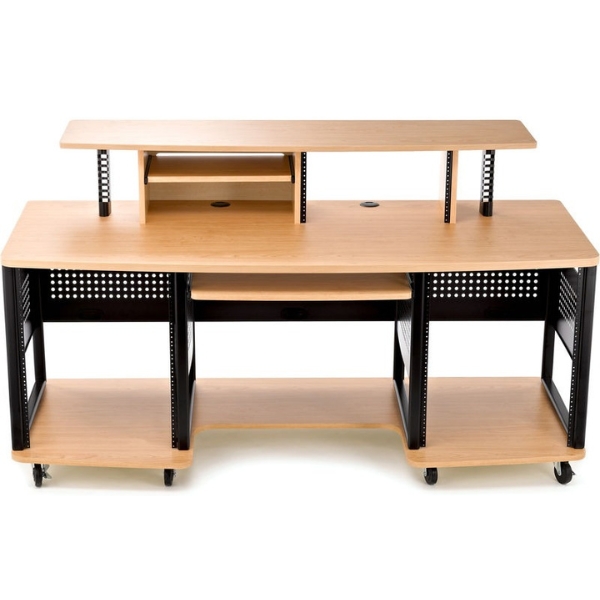
Dimensions: 72 x 41 x 30”
Features: Slide-out keyboard shelf, dual rack spaces
+ Versatile design
+ Plenty of space
- Finish is a bit '90s
The Studio RTA Producer Station is still one of the best studio desks around for the non-pro market and it’s incredibly well-priced considering what you get for your money. The looks might be plain, but it's an incredibly versatile studio desk.
Packing in a series of useful appointments like rack-spacing, slide-out shelving, and a raised section for monitors, this generously sized studio desk will fit the bill for those who have a decent amount of room and gear.
As one of the bigger names in studio furniture, Studio RTA has naturally thought of the small details here, too. We particularly like the sheer amount of space on offer, which is particularly useful if you have a dual-screen setup.
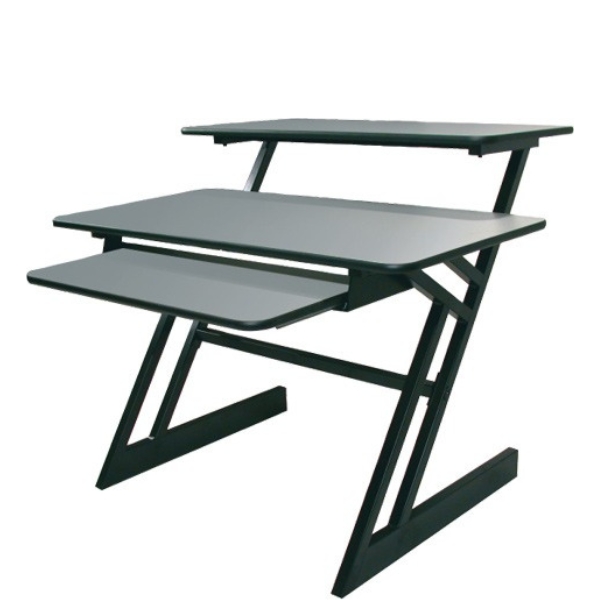
Dimensions: 44 x 36 x 22”
Features: Slide-out keyboard shelf, raised tier for monitors
+ Studio features
+ Compact size
- Easy to outgrow
Many of you may be working away in your bedroom or spare room, and when music production gear is squeezed in along with other bedroom furniture, this can make for a pretty cramped studio space and can impact your workflow.
The Quik-Lok Z250 makes an ideal desk for anyone in this situation. Why? Because it's a superb music-specific desk with features designed for the typical home studio. Combine that with a low price and you've got the perfect entry-level desk.
There’s a raised shelf for screens and nearfield monitors, a large main desk for controllers and keyboards, and a pull-out shelf for computer keyboards. Basically, everything you need and nothing you don’t, and all for a very reasonable price.
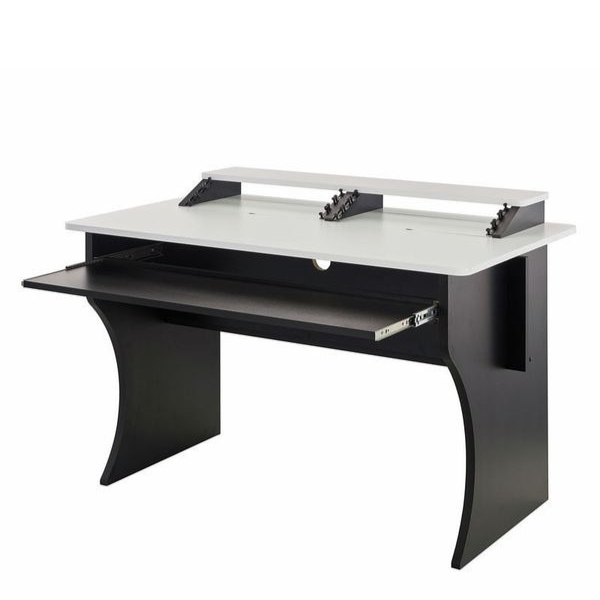
Dimensions: 1250 x 406 x 773mm
Features: 2 x 3U 19” racks, Pull-out keyboard shelf
+ Clever design
+ Cable management
- Some sharp edges
If you’ve been using an old desk or table, and are looking to invest in your first studio desk, then the Thomann ComboDesk is a superb option. It's only available online via Thomann, so remember to measure twice before ordering.
Designed by the good folk at Zaor, this collaboration features a bunch of musician-specific fixtures, like a pull-out keyboard shelf and space for rack-mounted gear, without skimping on the overall look and aesthetic.
It’s perhaps more than you’d spend if you went to a certain big-name Swedish furniture retailer, but then sometimes it’s worth splashing out on something specialist. Plus that Swedish furniture brand doesn't have built-in rack spaces!
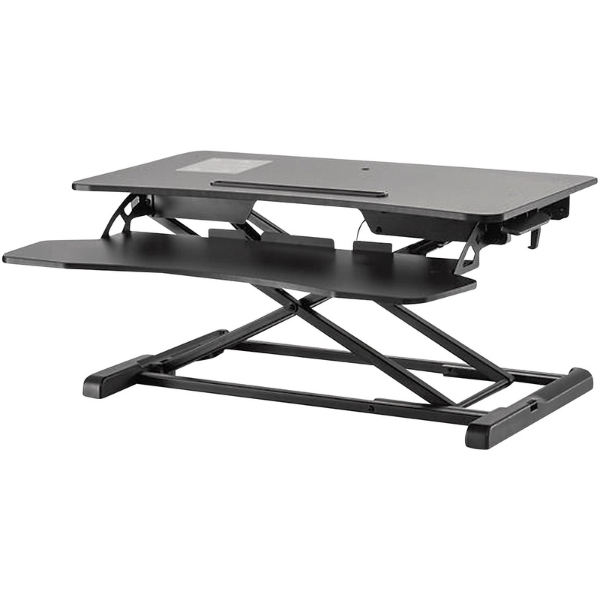
Dimensions: 31.5 x 4-19 x 24.2”
Features: Adjustable height
+ Improves your posture
+ Boosts your health
- Issues with lots of cables
Height adjustable desks (aka standing desks) are growing in popularity as they give users a chance to find a height that suits them. It raises up from 4 inches to 19 inches high, a superb option for those who want to get out of their studio chair.
In a studio environment, where lots of work is done sitting down, the chance to stretch your back and work standing up is beneficial to your overall health. If you suffer from 'tech neck', then this is the desk for you.
There are two tiers so you can have your monitor and keyboard separated and the whole thing is ruggedly built to last. Make sure you check what's plugged in before you raise it up though, the last thing you want is expensive gear hitting the floor.
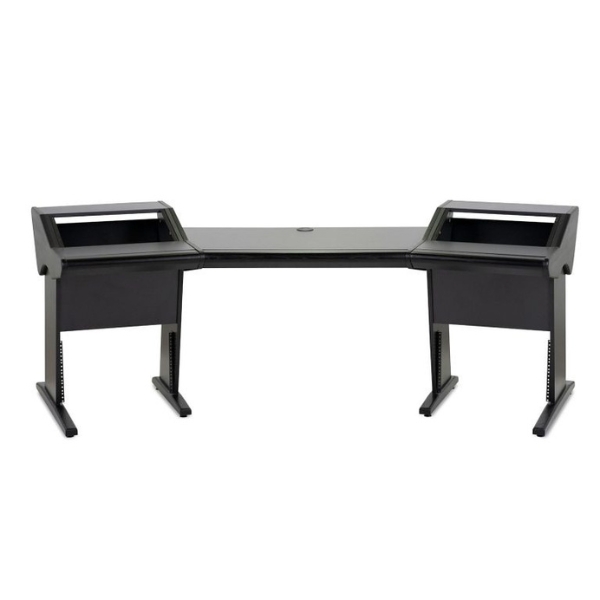
Dimensions: 1250 x 406 x 773mm
Features: 12 x 6U 19” racks, solid wood construction
+ Cable storage
+ Oak construction
- Not easy to move
If you’ve reached the stage in life where your studio needs, nay deserves, something large to house all your gear, then the Zaor Onda Angle is a worthy option to consider. Designed for professional engineers, this is a premium-level studio desk.
At its peak, the Onda is over 2.3 meters wide and weighs a whopping 66kg, so you’ll need to be fairly certain where you plan on situating it once it’s built. It's made from solid oak, making it one of the sturdiest options available.
We particularly liked the amount of built-in 19” rack space available - enough for 12 ‘regular’ modules - so you can go crazy with your vintage reverbs and compressors. You also get a vast surface on which to place your MIDI controllers and synthesizers.
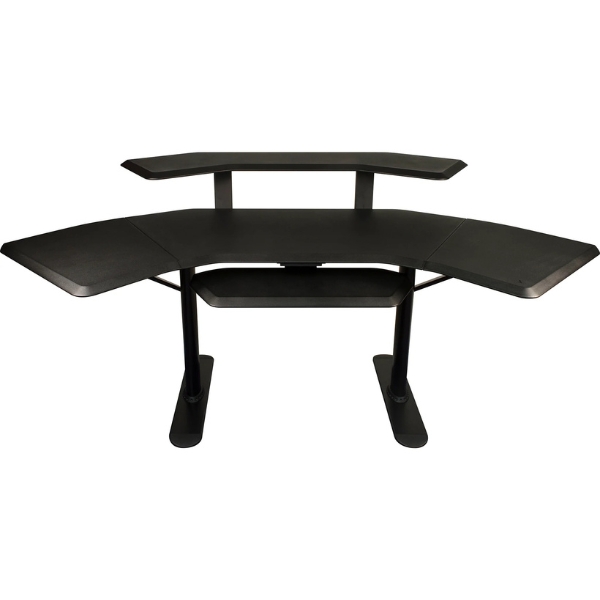
Dimensions: 84 x 39 x 44”
Features: Extended work surface, two-tier design
+ So much space
+ Improves workflow
- May not work for all rooms
There’s a practice in the field of manufacturing called ‘lean’, which essentially involves cutting out all unnecessary effort that impacts your work. Efficiency is the name of the game here and the Ultimate Support Nucleus 2 embodies this ethos perfectly.
By providing a huge workspace to operate from, but with two extension units that bring the sides of this studio desk around you. This should cut out plenty of chair-spinning and leaning, thus making for an improved workflow.
Its odd shape means it won't fit in every space, but for those with complex setups or lots of gear, this studio desk is up to the task. Add in a retractable keyboard shelf and you've got a studio desk that will shave hours off your usual workflow.
Load the next 4 products ↓
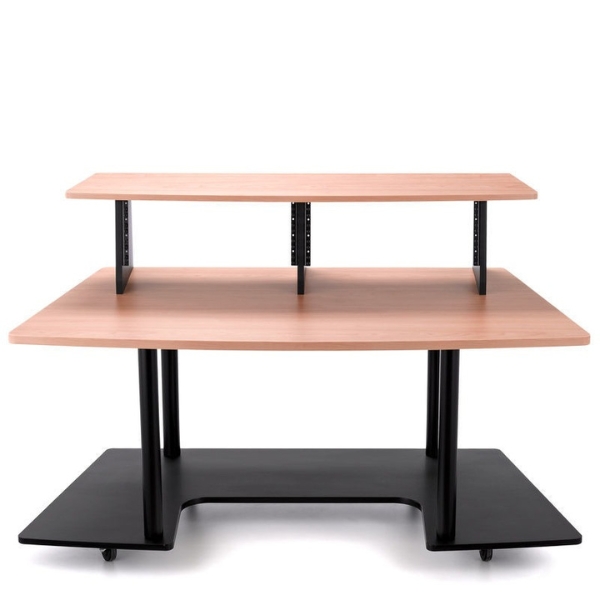
Dimensions: 59 x 30 x 37”
Features: Raised tier for monitors, dual 19” rack bays
+ Versatile
+ Lots of space
- No keyboard shelf
The Studio RTA Creation Station is a great all-around desk for anyone looking to step up from a more basic ‘flat surface’ type arrangement. It's excellent value for money and won't take up too much room.
Lots of producers will have a studio setup within a band’s rehearsal space for capturing demos on the fly. The creation station is an ideal desk for this as it packs in space for rack-mounted gear, along with a raised tier for your speakers.
It’s not enormous, so won’t dominate a smaller space, but it does contain enough space for controller keyboards and studio mixers. We also found the Creation Station ideal for anyone for whom recording isn’t the sole use of the desk.

Dimensions: 61 x 32 x 30”
Features: Large slide-out keyboard shelf
+ Perfect for keys
+ Acres of desk space
- No monitor stands
If your studio revolves around a single keyboard, synth, or arranger workstation then you probably don’t need masses of space for rack gear or computer towers. Maybe you're a composer who needs enough room to house a larger stage piano.
You’re still going to want something well-built and long-lasting, though, and we’re happy to recommend the Zaor Miza M in that case, even if you're not specifically a keyboard player. It's sturdily built and looks nice and sleek.
This well-proportioned workspace features a space-saving drawer that can house a 55-inch-wide keyboard and keep it tucked away when not in use. It's also got plenty of space up top for housing effects, controllers, and other studio gear.
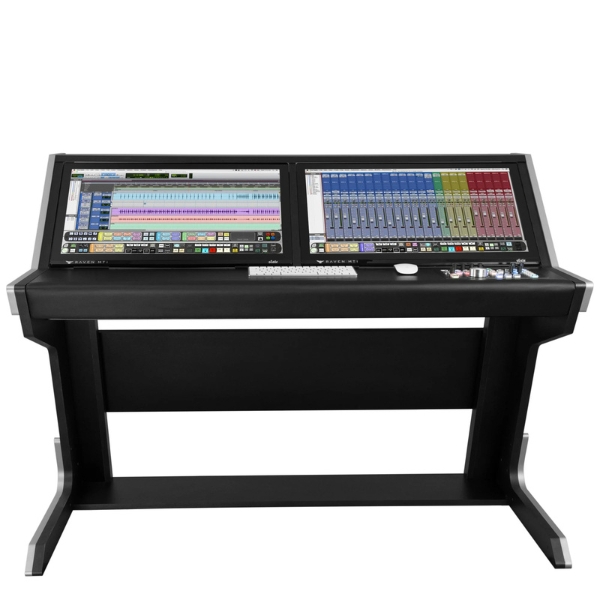
Dimensions: 56 x 42 x 32”
Features: Optional Dual DAW and software controllers
+ Very futuristic-looking
+ Touch workflow
- No space for monitors
Less a studio desk and more the control panel of a spaceship, the Slate Media Raven MTi Core Station is a glorious sight to behold. Clearly, this studio desk won’t be suitable for everyone, but it's perfect for pro-level producers.
The main attraction here are the two optional embedded 27-inch touchscreens, which house your favorite DAW and make everything controllable using multi-touch gestures. It's a high-end desk and it looks and feels the part.
Give it time and we can reasonably expect units like this to be more common (and hopefully cheaper) in the not-too-distant future. Until then, if you've got the money then this is a phenomenal addition to your studio workflow.

Dimensions: Various sizes available
Features: Folding design, built-in cable management, choice of designs and sizes
+ Cleverly designed
+ Cable management
+ Folds away
- Not for hardware-heavy setups
The DropTop series from Pith and Stem might not be the first name you think of for the best music studio desks, but we’ve grown pretty enamoured with ours. The basic concept is that the desk folds away and ‘hides’ behind a picture when it’s not in use.
Open it up, and you have a large desk area, with your monitor built in, and all those pesky cables hidden away from view. Close the lid and it becomes essentially a piece of wall art. For many people, the studio desk has to double up as a workspace and can often be located in kitchens, bedrooms, or living rooms.
The DropTop allows you to reclaim a degree of separation when you’re not working/producing, making it a desk that your family/housemates will appreciate as much as you do. It’s made to order, so isn’t cheap, but there is nothing else like it on the market.
Spec comparison
Here you'll find a direct comparison of all the models in this guide. We've included the dimensions as well as the key features they have to help you narrow down your selection if you're struggling to pick.
Model | Width | Height | Depth | Keyboard shelf? | Rack space? | Monitor shelf? |
|---|---|---|---|---|---|---|
StudioRTA Producer Station | 72" | 41" | 30" | Yes | Yes | Yes |
Quik-Lok Z-250 | 44" | 36" | 22" | Yes | No | Yes |
Thomann ComboDesk | 49" | 30" | 16" | Yes | Yes | Yes |
BK Media Work Station | 31.5" | 4-19" | 24.2" | Yes | No | No |
Zaor Onda Angle | 92" | 32" | 36" | No | Yes | Yes |
Ultimate Support Nucleus 2 | 84" | 39" | 44" | Yes | No | Yes |
StudioRTA Creation Station | 59" | 37" | 30" | No | Yes | Yes |
Zaor Miza M | 61" | 32" | 30" | Yes | No | No |
Slate Raven MTi Core Station | 56" | 42" | 32" | No | No | No |
Pith and Stem DropTop | Various | Various | Various | No | No | No |
How to choose
As a music producer, your workspace isn't just a desk - it's the centrepiece of your entire studio environment. That's why investing in a proper desk for your studio can revolutionize your workflow and boost your productivity.
Space
MusicRadar's got your back
One of the biggest perks of studio desks is their space-saving design. Even in cramped quarters, these desks are built to maximize efficiency, allowing you to squeeze in all your gear without sacrificing valuable studio real estate. Imagine having your keyboards, rackmounts, and essential equipment all within arm's reach, neatly organized and ready to go. This not only saves space but also eliminates the hassle of hunting down gear mid-session, keeping your creative flow uninterrupted.
Organisation
But it's not just about space - think about organisation too. With a dedicated studio desk, you can (mostly) wave goodbye to clutter and chaos. Everything has its place, from your audio interface to your effects gear, making it easier than ever to stay focused on your music without getting bogged down by piles of stuff everywhere.
Comfort
Perhaps most importantly, you need to think about your comfort. This is key when you're spending long hours in the studio, so studio desks have to fulfil that basic requirement. Designed with ergonomics in mind, the best studio desks offer features like adjustable height, wrist supports, and cable management to keep you comfortable and focused, even during marathon sessions. After all, a tidy desk isn't just for show - it's the foundation of a clear mind and a killer creative process.
Customisation
Customisation is important too. Studio desks offer a world of possibilities for tailoring your workspace to suit your needs. Many desks come equipped with built-in fixtures for mounting rack-mounted gear directly into the desk, giving you quick and easy access to your favourite tools and toys.
Value
When exploring budget-friendly options in the realm of studio desks, entry-level models often offer compact designs with essential features. These desks, while not showcasing the finest materials or trendiest aesthetics, deliver practicality with space-saving elements.
You can reasonably expect additions like sliding drawers for synthesizer storage or dual-layer designs creating room for MIDI pad controllers. As you ascend the price spectrum, superior construction quality becomes apparent.
Higher-end studio desks boast ergonomic designs and customizable spaces, allowing seamless integration of specialized equipment directly into the unit. These pricier alternatives elevate your studio setup, offering a blend of durability, comfort, and tailored functionality.
Room to grow
When a desk is in its ‘right’ place, it won’t usually be moved, so it’s important to make sure your chosen studio desk is the right size for the space you’re going to be working in and contains everything you need. Keep in mind future expansion too - your playing may require new equipment down the line, which may, in turn, require more space. Therefore it’s advisable to buy the biggest studio desk you can afford or find space for - it's not something you want to be replacing when you buy that new synth or upgrade to a double-screen setup, for example.
FAQs
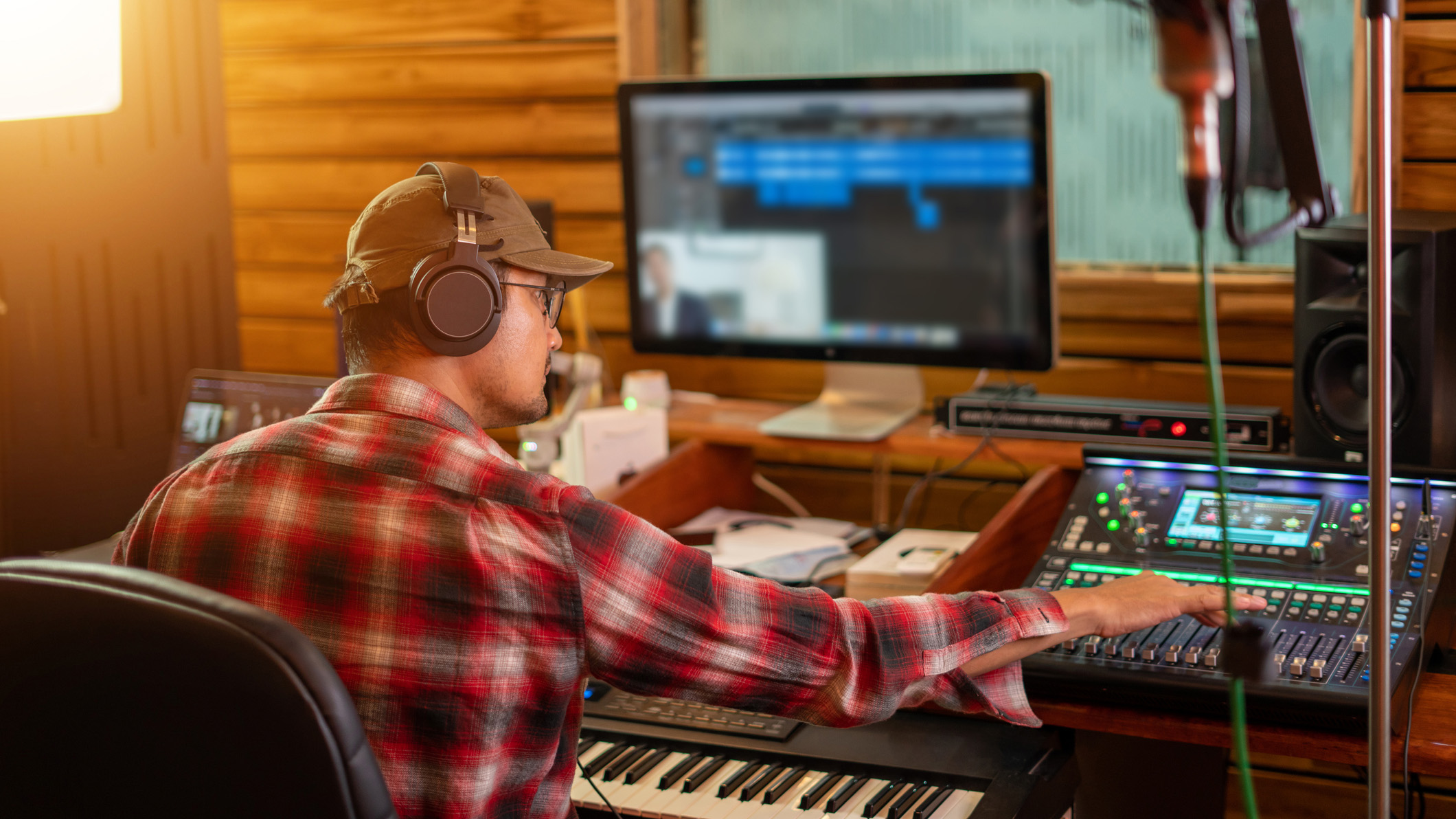
Do I need a studio desk?
Right now, you may have a battered old computer workstation overflowing with gear, or you may be rocking something far more palatial. Either way, a studio desk is a crucial part of almost any recording equation, and somewhere you can neatly lay out all your equipment.
We often underestimate how much impact the right studio desk can have: not only do they add valuable extra real estate for your stuff, but they can also reignite your creative fire by putting all of your kit within arms reach and inspiring you to work in new ways. If your gear is always set up and ready to go, then you can create the moment an idea hits you.
How much does a studio desk cost?
Studio desks aren't cheap by any means, so at a minimum you'll need something around the $/£150-200 mark in terms of budget. This should get you a decent setup with monitor stands, and may or may not get you a keyboard stand depending on which desk you go for. Of course, if you start spending more than that you'll gain access to rack space, better quality materials, and probably most importantly, more space.
What is the best height for a studio desk?
This is a very personal question and it all really depends on what your individual needs are. Ideally a studio desk will be tall enough that you can get a chair under it, as well as placing the monitors at ear height when you're sitting comfortably. You may have to make adjustments here to get things situated to your particular size, but you shouldn't have any issues with any of the desks in this guide.
How we choose
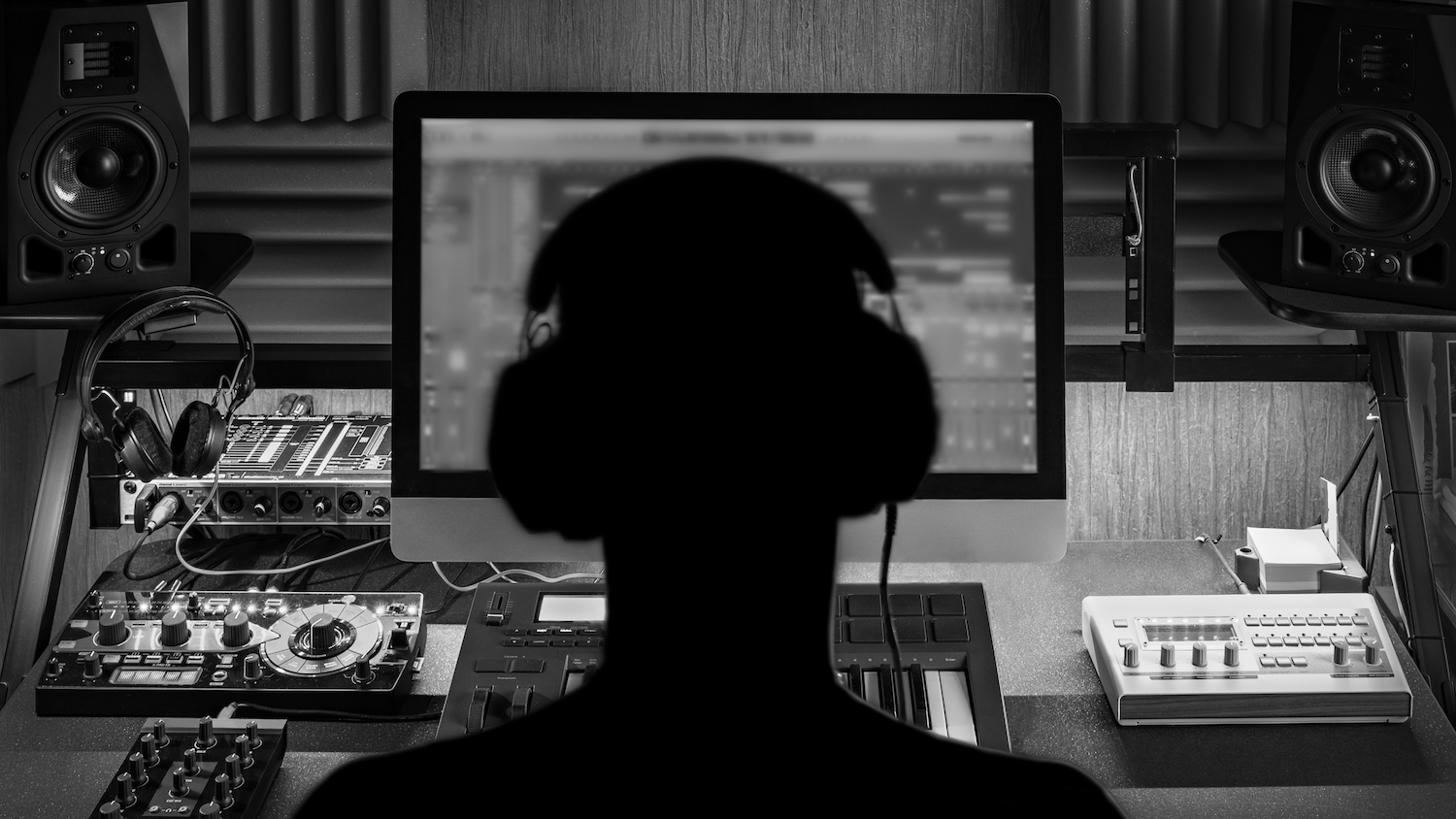
Here at MusicRadar, we are experts in our field, with many years of playing, creating and product testing between us. We live and breathe everything music gear related, and we draw on this knowledge and experience of using products in live, recording and rehearsal scenarios when selecting the products for our guides.
When choosing what we believe to be the best studio desks available right now, we combine our hands-on experience with a range of products in that category, as well as user reviews and testimonies and we engage in lengthy discussions with our editorial colleagues to reach a consensus about the top products in any given category.
First and foremost, we are musicians, and we want other players to find the right product for them. So we take into careful consideration everything from budget to feature set, ease of use and durability to come up with a list of what we can safely say are the best studio desks on the market right now.
Find out more about how we test music gear and services at MusicRadar.
Related buyer's guides
- The best studio chairs: are you sitting comfortably?
- Best laptops for music production
- Best studio headphones for music production
- The best computer monitors for music production
- The best external hard drives for music production
- Best home studio mixers: analogue and digital options
- 22 non-musical home studio upgrades for comfort and productivity
Want all the hottest music and gear news, reviews, deals, features and more, direct to your inbox? Sign up here.
Chris Corfield is a journalist with over 12 years of experience writing for some of the music world's biggest brands including Orange Amplification, MusicRadar, Guitar World, Total Guitar and Dawsons Music. Chris loves getting nerdy about everything from guitar and bass gear, to synths, microphones, DJ gear and music production hardware.
- Matt McCrackenJunior Deals Writer
